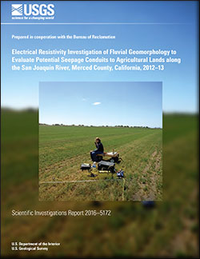Electrical resistivity investigation of fluvial geomorphology to evaluate potential seepage conduits to agricultural lands along the San Joaquin River, Merced County, California, 2012–13
Links
- Document: Report (5.43 MB pdf)
- Download citation as: RIS | Dublin Core
Abstract
Suggested Citation
Groover, K.D., Burgess, M.K., Howle, J.F., Philips, S.P., 2017, Electrical resistivity investigation of fluvial geomorphology to evaluate potential seepage conduits to agricultural lands along the San Joaquin River, Merced County, California, 2012–13: U.S. Geological Survey Scientific Investigations Report 2016–5172, 39 p., https://doi.org/10.3133/sir20165172.
ISSN: 2328-0328 (online)
Study Area
Table of Contents
- Abstract
- Introduction
- Methods
- Observations and Data
- Study Limitations
- Summary and Conclusions
- References Cited
- Appendix 1
| Publication type | Report |
|---|---|
| Publication Subtype | USGS Numbered Series |
| Title | Electrical resistivity investigation of fluvial geomorphology to evaluate potential seepage conduits to agricultural lands along the San Joaquin River, Merced County, California, 2012–13 |
| Series title | Scientific Investigations Report |
| Series number | 2016-5172 |
| DOI | 10.3133/sir20165172 |
| Publication Date | February 08, 2017 |
| Year Published | 2017 |
| Language | English |
| Publisher | U.S. Geological Survey |
| Publisher location | Reston, VA |
| Contributing office(s) | California Water Science Center, Volcano Hazards Program, Volcano Science Center |
| Description | vii, 39 p. |
| Country | United States |
| State | California |
| County | Merced County |
| Other Geospatial | San Joaquin River |
| Online Only (Y/N) | Y |


